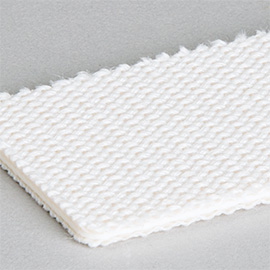 There are two basic types of fabrics used in the production of Nitta conveyor belts: rigid and non-rigid fabric.
There are two basic types of fabrics used in the production of Nitta conveyor belts: rigid and non-rigid fabric.
R-fabric - rigid fabric for conveyor belts
R-fabric, or rigid fabric, has a monofilament yarn running across the belt, which ensures that Nitta conveyor belts have a good lateral stability.
There are several varieties of rigid fabrics, which depend on the type of monofilament yarn. Nitta differentiates:
- (U)LR-weefsel light rigid
- HR-weefsel, rigid-low stretch
N-fabric - non-rigid fabric for conveyor belts
N-fabric, or non-rigid fabric, is flexible in the length and width and is used in troughed bulk transport or curved conveyors.
Special fabrics for conveyor belts
- RZ-fabric, this fabric is often used for belts deployed in bakeries. It is a combination of a monofilament yarn with a viscose yarn. This creates a thicker crave for heavy dough products.
- DRA-fabric, is an interwoven polyester fabric.
- XR-fabric, gives extreme lateral stability and can be used in chocolate cooling tunnels, and swanneck conveyors.
Other fabrics for conveyor belts
- CP-fabric, or cotton/polyester fabric, has cotton fill yarns for moisture absorption and polyester warp yarns for strength and low stretch. Cotton fabric is used for non-sticking applications for dough or uncured rubber.
- W-fabric, or whisper fabric, also called low-noise fabric. Its special structure decreases the noise a belt makes while running on conveyors. It is used in areas where people are nearby, such as airports, distribution centres or for treadmills in gyms.
- M-Fabric is a high-strength fabric used for extremely heavy-duty operations, such as marble and granite grinding or moving floors in trucks. The monofilament in the fabric assists in the flatness and tracking of the belts.
- Y-fabric, a very strong fabric for applications where a low stretch is required.
Antistatic fabric compositions
Some types of fabric (R, LR, DR, XR, N, W) can be combined with a carbon yarn that gives the belts antistatic qualities.



